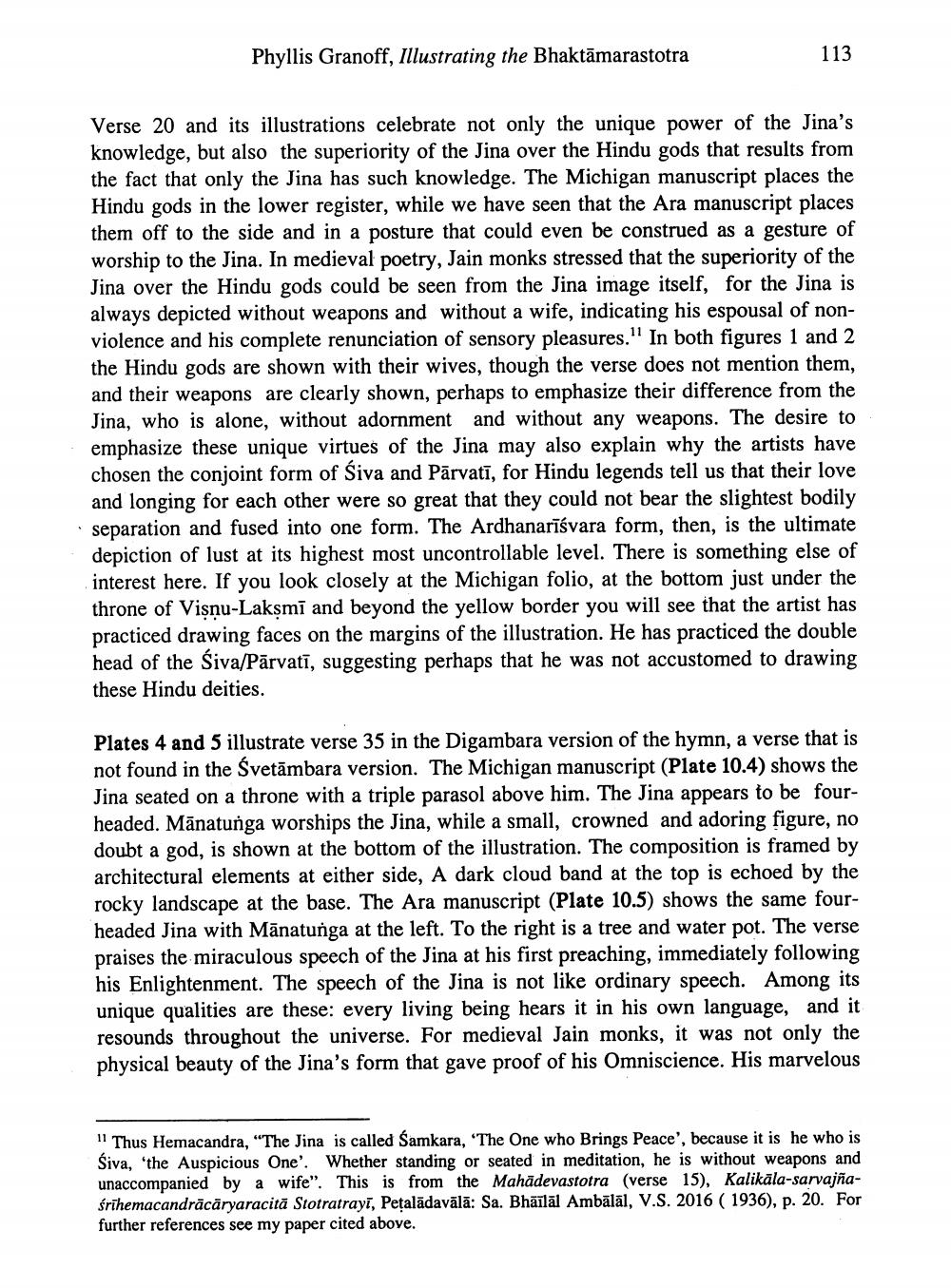________________
Phyllis Granoff, Illustrating the Bhaktāmarastotra
113
Verse 20 and its illustrations celebrate not only the unique power of the Jina's knowledge, but also the superiority of the Jina over the Hindu gods that results from the fact that only the Jina has such knowledge. The Michigan manuscript places the Hindu gods in the lower register, while we have seen that the Ara manuscript places them off to the side and in a posture that could even be construed as a gesture of worship to the Jina. In medieval poetry, Jain monks stressed that the superiority of the Jina over the Hindu gods could be seen from the Jina image itself, for the Jina is always depicted without weapons and without a wife, indicating his espousal of nonviolence and his complete renunciation of sensory pleasures." In both figures 1 and 2 the Hindu gods are shown with their wives, though the verse does not mention them, and their weapons are clearly shown, perhaps to emphasize their difference from the Jina, who is alone, without adornment and without any weapons. The desire to emphasize these unique virtues of the Jina may also explain why the artists have chosen the conjoint form of Siva and Pārvatī, for Hindu legends tell us that their love and longing for each other were so great that they could not bear the slightest bodily separation and fused into one form. The Ardhanarīśvara form, then, is the ultimate depiction of lust at its highest most uncontrollable level. There is something else of interest here. If you look closely at the Michigan folio, at the bottom just under the throne of Visnu-Laksmī and beyond the yellow border you will see that the artist has practiced drawing faces on the margins of the illustration. He has practiced the double head of the Siva/Pārvatī, suggesting perhaps that he was not accustomed to drawing these Hindu deities.
Plates 4 and 5 illustrate verse 35 in the Digambara version of the hymn, a verse that is not found in the Svetāmbara version. The Michigan manuscript (Plate 10.4) shows the Jina seated on a throne with a triple parasol above him. The Jina appears to be fourheaded. Mānatunga worships the Jina, while a small, crowned and adoring figure, no doubt a god, is shown at the bottom of the illustration. The composition is framed by architectural elements at either side, A dark cloud band at the top is echoed by the rocky landscape at the base. The Ara manuscript (Plate 10.5) shows the same fourheaded Jina with Mānatunga at the left. To the right is a tree and water pot. The verse praises the miraculous speech of the Jina at his first preaching, immediately following his Enlightenment. The speech of the Jina is not like ordinary speech. Among its unique qualities are these: every living being hears it in his own language, and it resounds throughout the universe. For medieval Jain monks, it was not only the physical beauty of the Jina's form that gave proof of his Omniscience. His marvelous
1 Thus Hemacandra, “The Jina is called Samkara, 'The One who Brings Peace', because it is he who is Śiva, 'the Auspicious One'. Whether standing or seated in meditation, he is without weapons and unaccompanied by a wife". This is from the Mahādevastotra (verse 15), Kalikāla-sarvajñaśrihemacandrācāryaracitā Stotratrayi, Petalādavālā: Sa. Bhailäl Ambālāl, V.S. 2016 (1936), p. 20. For further references see my paper cited above.




